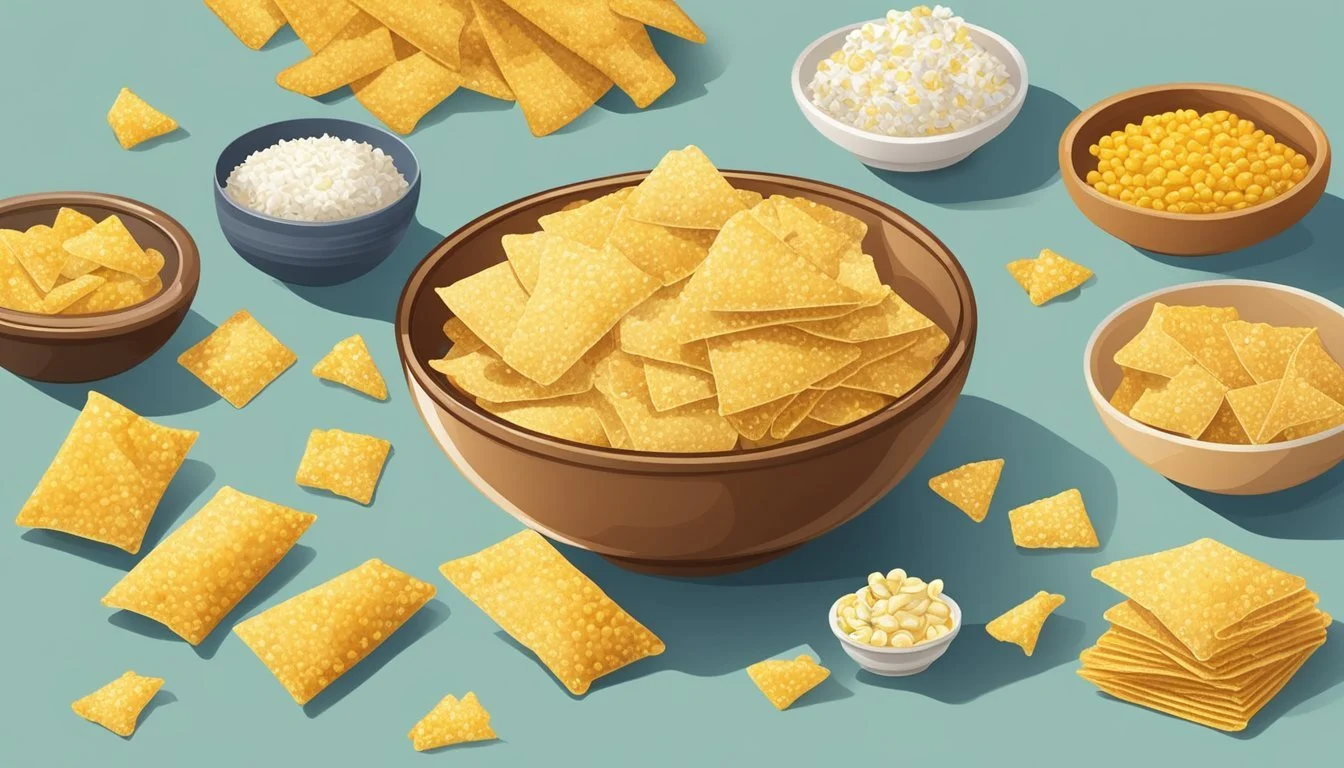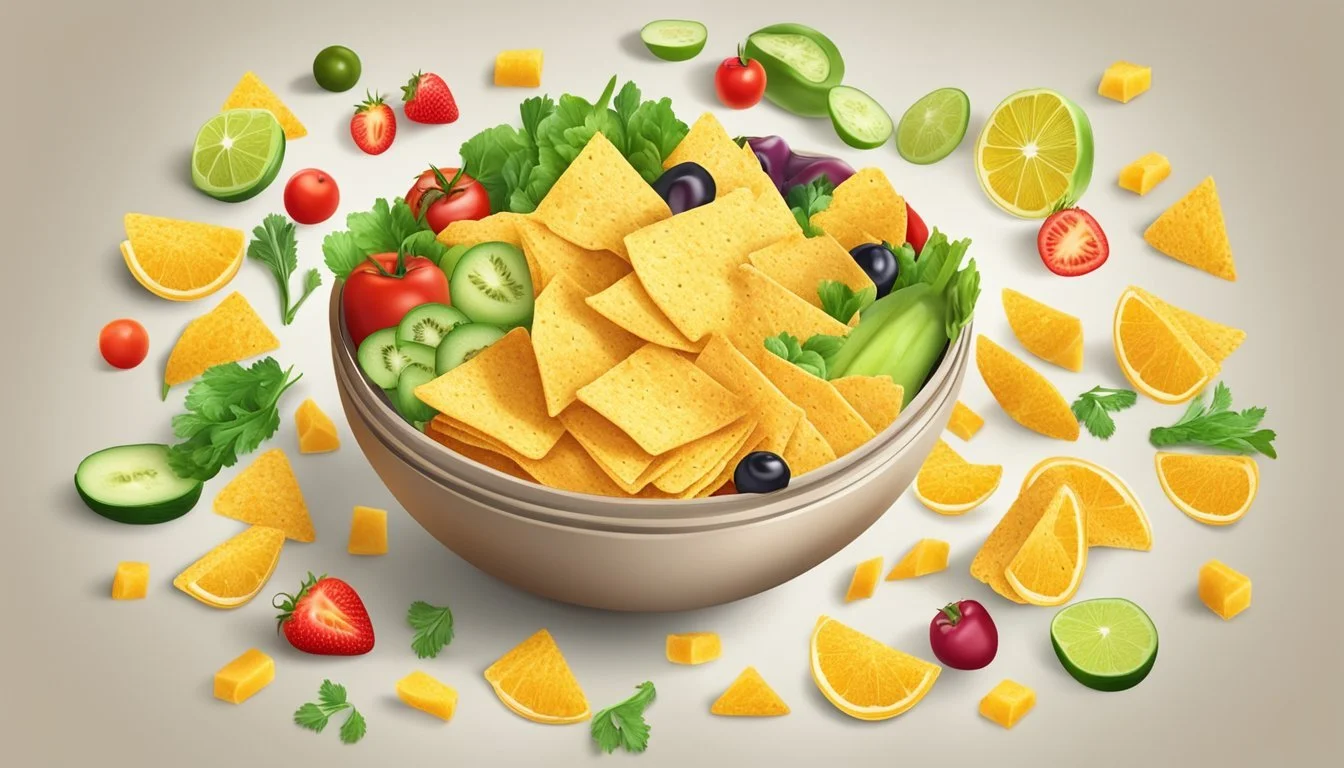Corn Chips Substitutes
Healthier and Tasty Alternatives
Looking for tasty alternatives to corn chips that won’t compromise flavor or crunch? Healthy alternatives such as air-fried vegetables, popcorn, and baked kale chips offer nutritious and satisfying options. They can be enjoyed just as much as traditional corn chips and without the guilt.
For example, air-fried pickle chips or roasted chickpeas can bring an exciting variety to your snack routine with their crispiness. Popcorn, especially when lightly salted, provides that crunchy texture many crave in chips while being lower in fat and calories.
Additionally, baked kale chips, made by simply tossing kale pieces in a bit of olive oil and baking them, deliver a nutritious punch with fiber and essential vitamins. These swaps not only curb your chip cravings but also contribute positively to a healthier lifestyle.
Understanding Corn Chips
Corn chips are a popular snack made primarily from corn. They are typically deep-fried, resulting in a savory and crunchy treat.
Nutritional Profile
Corn chips have a notable nutritional profile. A typical serving of corn chips contains around 150-200 calories, making them a calorie-dense snack. The primary macronutrients found in corn chips include carbs, fat, and a small amount of protein.
A single serving may provide about 15-20 grams of carbs, which includes simple sugars. Fat content ranges from 8-10 grams per serving, with a portion of it being saturated fat. They also contain about 2 grams of dietary fiber, beneficial for digestion. Additionally, corn chips offer small amounts of vitamins and minerals, such as iron.
Here's a summary of a typical nutritional profile in a single serving:
Calories: 150-200
Carbs: 15-20g
Fat: 8-10g (saturated fat included)
Protein: 2-3g
Fiber: 2g
Iron: Small amounts
Texture and Taste Factors
The texture and taste of corn chips are key to their popularity. Corn chips are traditionally crisp and crunchy, making them an enjoyable snack to munch on. The texture comes from the process of frying or baking the corn dough.
Taste-wise, corn chips often have a savory profile. The corn flavor is typically highlighted, complemented by added seasonings. This creates a flavorful and addictive taste experience. Whether plain or with flavors like BBQ or cheese, corn chips offer a versatile snacking option.
The texture and taste can vary slightly depending on the brand and manufacturing process, but the core characteristics remain. The delightful crunch combined with robust flavors makes corn chips a favorite for many.
Types of Corn Chips Alternatives
To maintain a healthy diet while satisfying snack cravings, a variety of corn chip alternatives are available. These substitutes cater to different dietary needs such as vegan, gluten-free, and high-protein options. Below are the main categories of these alternatives:
Vegetable-Based Chips
Kale chips are a popular choice, known for being crispy and nutrient-dense. They are easy to make at home by baking kale leaves with a light coat of olive oil. Kale chips are rich in vitamins A, C, and K, as well as antioxidants.
Zucchini chips offer a low-calorie and gluten-free option. Sliced thin and baked until crispy, they can be seasoned with various spices to enhance flavor. They provide a good source of vitamins B6 and C, potassium, and fiber.
Sweet potato chips are another nutritious alternative. Rich in beta-carotene, vitamins A and C, and fiber, they can be sliced, lightly oiled, and baked to a perfect crunch. They are also gluten-free and can be part of a vegan diet.
Legume and Grain-Based Chips
Black bean chips are a fiber-rich, protein-enriched alternative. Made primarily from black beans, these chips are often seasoned to create a savory snack that’s also gluten-free. They provide essential nutrients like iron, magnesium, and antioxidants.
Chickpea flour chips, known for their crispy texture, are gluten-free and often used in vegan recipes. Chickpeas are high in protein and fiber, making them a satisfying and healthier choice. These chips can also be seasoned variously for added taste.
Quinoa chips combine the protein-packed grain with other ingredients for a crunchy snack. Quinoa is high in protein, fiber, and essential amino acids, making it ideal for those on a gluten-free or vegan diet. These chips are often marketed as being nutrient-rich and suitable for keto diets as well.
Protein-Enriched Chips
Soy chips utilize soy protein to offer a high-protein, low-carb snack. They are perfect for those on a keto diet and are often gluten-free. These chips provide a substantial amount of protein, making them filling and nutritious.
Whey protein isolate chips are designed specifically for those looking to increase their protein intake. These chips are often low in carbs and fat, making them suitable for fitness enthusiasts and those on a keto diet. They come in various flavors to cater to different taste preferences.
Almond flour chips provide a low-carb and high-protein alternative. Made from ground almonds, these chips are gluten-free and often fit into vegan diets. They offer healthy fats, protein, and fiber, making them a balanced and nutritious snacking option.
Homemade Chips Alternatives
Homemade chip alternatives offer nutritious and tasty options for those seeking healthier snacks. The following sections highlight various baking techniques and specialty ingredients to create delicious substitutes for traditional corn chips.
Baking and Seasoning Techniques
Using baking as a cooking method provides a healthier alternative to frying. Sweet potato chips, for instance, can be thinly sliced using a mandoline, then tossed with olive oil and a pinch of salt. For additional flavor, sprinkle with rosemary or thyme before baking.
Zucchini can also be transformed into chips. Slice zucchini thinly, season with olive oil, garlic powder, and a bit of pepper, then bake until crisp. Beets make an excellent savory or sweet chip alternative. Slice them thin, toss with olive oil, and add a dash of cinnamon or cayenne, depending on your flavor preference.
Kale chips are another popular option. Remove the stems from the kale, tear the leaves into chip-sized pieces, lightly coat with olive oil, and season with salt and pepper. Bake until crispy. These techniques ensure the chips are both flavorful and healthy.
Specialty Ingredients
Specialty ingredients can enhance the nutritional profile of homemade chips. Using coconut flour and almond flour in coatings can add a unique texture and boost fiber content. For a protein boost, egg whites can be used to coat the chips before seasoning.
Chia seeds and flax seeds are excellent additions. They can be mixed into seasoning blends to provide extra crunch and nutritional benefits. For instance, adding a mixture of chia seeds and cayenne to a batch of zucchini chips can offer both heat and crunch.
Baking with these ingredients makes homemade chips an excellent option for weight loss diets. Using spices like rosemary, thyme, and cinnamon not only adds flavor but can also provide additional health benefits, making these snacks both delicious and nutritious.
Store-Bought Alternatives
For those seeking alternatives to traditional corn chips, several store-bought options cater to different dietary needs and flavor preferences.
Health-Focused Brands
Some brands prioritize health, offering options that are gluten-free, low-carb, and vegan. Bada Bean Bada Boom provides high-protein and high-fiber snacks made from broad beans. Quevos, made with egg whites, packs in 8 grams of protein and 4 grams of fiber. Kale chips are another nutritious alternative, like those from Brad's Plant Based—packed with vitamins and minerals, perfect for keto dieters.
Sweet potato chips are also popular, offering a slightly sweet flavor while being rich in vitamins A and C. Bare Snacks specializes in baked, not fried, snacks which preserve nutrients better than traditional frying methods.
Flavor and Texture Variety
One of the joys of snacking is the variety of flavors and textures available. Popcorners, for example, come in flavors like Cheddar Cheese, Sour Cream, and Jalapeno, offering a satisfying crunch that rivals traditional chips.
Those looking for something more complex should try Pulp Pantry Pulp Chips, available in flavors like Barbecue and Quezo. These chips are made from vegetable pulp, providing a unique texture and taste, while also being high in fiber.
For something off the beaten path, Rhythm Superfoods offers crunchy kale and beet chips with a variety of seasonings to please any palate, from tangy to zesty.
These options offer both distinctive textures and flavors, ensuring that there's something for everyone without compromising on taste or nutritional value.
Dietary Considerations
When choosing corn chip substitutes, it's crucial to consider factors like carbohydrate content, calories, and potential allergens. This section focuses on options that cater to low-carb and ketogenic diets, as well as managing common allergies and intolerances.
Low-Carb and Ketogenic Options
For those following a low-carb or ketogenic diet, the carbohydrate content of snacks is a primary concern. Pork rinds and cheese crisps are excellent substitutes as they are both low in net carbs and high in protein.
Pork rinds: Zero net carbs, high in protein, and packed with flavor. They provide a satisfying crunch similar to corn chips.
Cheese crisps: Made from baked cheese slices, around 1g of net carbs per serving. They are also high in protein and fats, making them suitable for ketogenic diets.
Other healthy alternatives include vegetable chips made from kale or zucchini, which can be baked with olive oil. Kale chips are particularly beneficial due to their high fiber content and low calories, aligning well with weight loss goals.
Managing Allergies and Intolerances
For individuals managing allergies and intolerances, options free from common allergens like gluten, dairy, and nuts are essential. Popcorn is often gluten-free and can be found in options that are butter-free and low in calories.
Popcorn: Naturally gluten-free. Look for brands that are also dairy-free and soy-free to accommodate multiple dietary needs.
Rice cakes: A versatile and low-calorie option that is typically gluten-free and can be found without dairy ingredients.
For those with nut allergies, soy-based snacks can offer a safe and nutritious alternative. Ingredients should be carefully checked to avoid any hidden allergens. Quinoa chips and lentil chips provide additional options that are soy-free and often available in gluten-free varieties as well.
By focusing on these dietary considerations, individuals can enjoy satisfying snacks without compromising on their health or taste preferences.
Alternative Chips Pairings
Choosing the right combinations of dips, toppings, and meal complements can enhance your experience with alternative chips. These pairings ensure you enjoy a variety of flavors and nutrition.
Dips and Toppings
Dipping alternative chips in flavorful salsa, guacamole, and hummus can offer a delicious boost. Salsa, with its blend of onions, garlic, and herbs, adds a zesty and refreshing taste. Guacamole offers a creamy texture combined with healthy fats. Hummus provides a savory option that is rich in protein and pairs well with many chip alternatives.
For those who prefer a creamier touch, ranch dip is a great option. Another excellent choice is queso, a melted cheese dip that adds a rich and savory flavor to your chips. Whether you enjoy the crunch of kale chips or the unique flavor of bean chips, the right dip can make a significant difference.
Meal Complements
Alternative chips can also serve as excellent meal complements. They pair well with chicken, fish, and tofu dishes, adding a satisfying crunch. Imagine a plate of grilled chicken breast served alongside nutrient-rich kale chips or crispy bean chips to complement a dish.
Incorporating chip alternatives into salads can provide added texture and taste. Topping a spinach salad with crushed lentil or quinoa chips can enhance the flavor and make for a more filling meal. These chips can also be used in various nachos recipes where a healthier alternative is desired.
Choosing the right combinations ensures that alternative chips not only serve as a tasty snack but also integrate seamlessly into meals, enhancing the overall dining experience.
Creative Cooking Methods
Exploring creative cooking methods for corn chip substitutes can offer healthier and flavorful alternatives. Techniques like air-frying, oven-baking, and using unique ingredients provide exciting ways to enjoy crispy snacks with fewer calories.
Air-Frying Alternatives
Air-frying is an excellent method for crafting healthy corn chip substitutes. Sweet potatoes and zucchini slices can be lightly coated in olive oil and spices before being air-fried for a crispy exterior and tender interior. This method maintains a satisfying texture while reducing added fats. Radish and taro chips also work well, absorbing flavors like garlic powder and paprika for a savory taste. Air-frying brings out robust flavors without compromising on health, creating crunchy and delightful snacks.
Oven-Baked Innovations
When it comes to oven-baking, the range of ingredient options expands significantly. Butternut squash slices, beet chips, and kale leaves make fantastic baked alternatives. Sprinkling olive oil and sea salt over these ingredients before baking results in delicious crispiness. Experimenting with different levels of doneness, from lightly browned to deeply roasted, can yield various textures to cater to different preferences. Baking not only retains the nutrients but also allows for a wide variety of seasoning choices to enhance the natural flavors.
Unique Ingredients and Flavors
Using unique ingredients introduces novel textures and flavors to corn chip substitutes. Rice flour and wheat flour coatings provide a distinctive crunch when used with thinly sliced vegetables like taro and butternut squash. Incorporating nuts and seeds, such as crushed almonds or sesame seeds, adds an extra layer of texture and richness. Bold combinations like spiced chickpeas or seasoned baked tortilla strips offer a satisfying crunch and a burst of flavor. These inventive ingredients ensure that each bite delivers a memorable culinary experience.
Nutritional Benefits
Corn chip substitutes offer various nutritional advantages that make them a healthier choice. They typically contain a better balance of macronutrients, fewer calories, and can pack in essential vitamins and minerals beneficial for overall health.
Macronutrients and Calories
These substitutes often have improved macronutrient profiles compared to traditional corn chips. Protein content is usually higher in options like bean chips or popcorn, making them more satisfying. For example, snacks such as Bada Bean Bada Boom contain 7 grams of protein per serving, which helps maintain muscle mass and keeps hunger at bay.
Calorie content is another advantage. Many alternatives provide fewer calories per serving, making them a better choice for weight management. Quevos, made from egg whites, are an example with low-calorie counts yet rich in protein and fiber. Fiber is significant in these substitutes, aiding digestion and promoting fullness. A good fiber source can lead to better gastrointestinal health.
Vitamins and Minerals
Many substitutes also offer enhanced levels of essential vitamins and minerals. For instance, veggie-based chips like Pulp Pantry Pulp Chips leverage the nutrients found in vegetables such as kale and celery. These can provide increased levels of vitamin A, which is crucial for vision and immune function, and iron, vital for oxygen transport in the blood.
Popcorn options, often overlooked, can be enriched with additional vitamins like B-vitamins and minerals such as magnesium, supporting various bodily functions. Their natural whole-grain composition also means they provide more micronutrients than most processed snacks.








